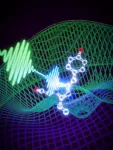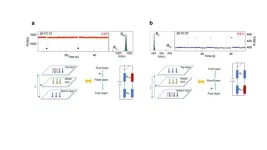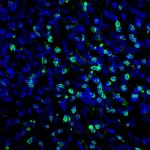(Press-News.org) Bringing ultrafast physics to structural biology has revealed the dance of molecular ‘coherence’ in unprecedented clarity.
How molecules change when they react to stimuli such as light is fundamental in biology, for example during photosynthesis. Scientists have been working to unravel the workings of these changes in several fields, and by combining two of these, researchers have paved the way for a new era in understanding the reactions of protein molecules fundamental for life.
The large international research team, led by Professor Jasper van Thor from the Department of Life Sciences at Imperial, report their results today in the journal Nature Chemistry.
Crystallography is a powerful technique in structural biology for taking ‘snapshots’ of how molecules are arranged. Over several large-scale experiments and years of theory work, the team behind the new study integrated this with another technique that maps vibrations in the electronic and nuclear configuration of molecules, called spectroscopy.
Demonstrating the new technique at powerful X-ray laser facilities around the world, the team showed that when molecules within the protein that they studied are optically excited, their very first movements are the result of ‘coherence’. This shows a vibrational effect, rather than motion for the functional part of the biological reaction that follows.
This is important distinction, shown experimentally for the first time, highlights how the physics of spectroscopy can bring new insights to the classical crystallography methods of structural biology.
Professor van Thor said: “Every process that sustains life is carried out by proteins, but understanding how these complex molecules do their jobs depends on learning the arrangement of their atoms – and how this structure changes – as they react.
“Using methods from spectroscopy, we can now see ultrafast molecular movements that belong to so-called coherence process directly in pictorial form by solving their crystal structures. We now have the tools to understand, and even control, molecular dynamics on extremely fast timescales at near-atomic resolution.
“We hope by sharing the methodological details of this new technique we can encourage researchers in both the fields of time-resolved structural biology as well as ultrafast laser spectroscopy to explore the crystallographic structures of coherences.”
Combining techniques
Combining the techniques required the use of X-ray free-electron laser (XFEL) facilities, including the Linac Coherent Light Source (LCLS) in the USA, the SPring-8 Angstrom Compact free electron LAser (SACLA) in Japan, the PAL-XFEL in Korea and recently also the European XFEL in Hamburg.
Members of the team have been working since 2009 at XFELs to use and understand the motions of reacting proteins on the femtosecond (one millionth of one billionth of a second) timescale, known as femtochemistry. Following excitation by a laser pulse, ‘snapshots’ of the structure are taken using X-rays.
Early success with this technique in 2016 resulted in a detailed picture of the light-induced change in a biological protein. However, researchers still needed to address a key question: what is the origin of the tiny molecular 'motions' on the femtosecond time scale directly after the first laser light pulse?
Previous studies had assumed that all the motions correspond to the biological reaction, meaning its functional motion. But using the new method, the team found that this wasn’t the case in their experiments.
Coherent control
To reach this conclusion they created ‘coherent control’ – shaping the laser light to control the protein’s motions in a predictable manner. Following initial success in 2018 at LCLS in Stanford, checking and verifying the method required a total of six experiments at XFEL facilities around the world, each time assembling large teams and forming international collaborations
They then combined the data from these experiments with theoretical methods modified from femtochemistry, in order to apply them to X-ray crystallographic data rather than to spectroscopic data.
The conclusion was that the ultrafast motions measured with exquisite accuracy on the picometer scale and femtosecond time scale do not belong to the biological reaction, but instead to vibrational coherence in the remaining ground state.
This means that the molecules that are 'left behind' after the femtosecond laser pulse has passed dominate the motions that are subsequently measured, but only within the so-called vibrational coherence time.
Professor van Thor said: “We concluded that for our experiment, also if coherent control was not included, the conventional time resolved measurement was in fact dominated by motions from the dark ‘reactant’ ground state, which are unrelated to the biological reactions that are triggered by the light. Instead, the motions correspond to what is traditionally measured by vibrational spectroscopy and have a very different, but equally important, significance
“This was actually predicted based on theoretical work made previously, but has now been shown experimentally. This will have significant impact in both the fields of time resolved structural biology as well as ultrafast spectroscopy, as we have developed and provided the tools for analysis of ultrafast femtosecond time scale motion.”
Unprecedented collaboration
The paper includes 49 authors from 15 institutions, covering work over seven years, including experiments conducted remotely during the pandemic. It’s this sense of collaboration that made the result possible, according to Professor van Thor.
He said: “In a fast-moving field, where XFEL beamtime applications are incredibly competitive and there is pressure to publish from each individual experiment, I am extremely grateful to all the co-authors, team members and collaborators for their perseverance, hard work and investment in pursuing the greater objective, which required the strategic and much longer route that we have taken.”
Co-author Dr Sébastien Boutet, from the SLAC National Accelerator Laboratory, which hosts the LCLS, said: “These results represent what is truly unique about the capabilities of x-ray lasers. It demonstrates the type of knowledge on biology in motion that can only be achieved with very short bursts of x-rays and combined with cutting edge laser technology. We see an exciting future of discovery in this area.”
Co-author Professor Gerrit Groenhof, from the University of Jyväskylä, Finland, said: “Using coherent control to extracting the relevant molecular dynamics in the electronic excited state from other motions induced by the excitation laser is essential to understand how photoreceptor proteins have evolved to mediate the photo-activation process. Seeing such a molecular movie of photobiology in action is not only fascinating, but may also be the key to unlock biological principles for designing new light-responsive materials.”
END
Making molecules dance to our tune reveals what drives their first movements
2023-08-10
ELSE PRESS RELEASES FROM THIS DATE:
Gut microbiome can increase risk, severity of HIV, EBV disease
2023-08-10
CHAPEL HILL, N.C. – Over the past decade, the gut microbiome has gained significant interest by scientists and non-scientists alike. Recent research has shown that the bacteria and other microbes in our gut play a supporting role in immunity, metabolism, digestion, and the fight against "bad bacteria" that try to invade our bodies.
However, new research published in Nature Biotechnology by Angela Wahl, PhD, Balfour Sartor, MD, J. Victor Garcia, PhD, and UNC School of Medicine colleagues others has revealed that the microbiome may not as always be protective against human pathogens.
Using a first-of-its-kind ...
YALE EMBARGOED NEWS: Yale scientists reveal two paths to autism in the developing brain
2023-08-10
New Haven, Conn. — Two distinct neurodevelopmental abnormalities that arise just weeks after the start of brain development have been associated with the emergence of autism spectrum disorder, according to a new Yale-led study in which researchers developed brain organoids from the stem cells of boys diagnosed with the disorder.
And, researchers say, the specific abnormalities seem to be dictated by the size of the child’s brain, a finding that could help doctors and researchers to diagnosis and treat autism in the future.
The findings were ...
Before reaching the skies, the Himalayas had a leg up, new study shows
2023-08-10
Mountain ranges play a key role in global climate, altering weather and shaping the flora and fauna that inhabit their slopes and the valleys below. As warm air rises windward grades and cools, moisture condenses into rain and snow. On the leeward side, it’s quite the opposite. Deserts prevail, a phenomenon known as rain shadow. Thus, the way mountain ranges form is a matter of intense interest among those who study and model climates of the past.
That debate will soon grow more heated with a new paper in the journal Nature Geoscience. A team of researchers ...
Scientists harness the power of AI to shed light on different types of Parkinson’s disease
2023-08-10
Francis Crick Institute press release
Under strict embargo: 16:00hrs BST 10 August 2023
Peer reviewed
Observational study
Cells
Researchers at the Francis Crick Institute and UCL Queen Square Institute of Neurology, working with technology company Faculty AI, have shown that machine learning can accurately predict subtypes of Parkinson’s disease using images of patient-derived stem cells.
Their work, published today in Nature Machine Intelligence, has shown that computer models can accurately classify four subtypes of Parkinson’s disease, with one reaching an accuracy of 95%. This could pave the way for personalised medicine and targeted drug discovery.
Parkinson’s ...
Researchers discover a potential application of unwanted electronic noise in semiconductors
2023-08-10
Random Telegraph Noise (RTN), a type of unwanted electronic noise, has long been a nuisance in electronic systems, causing fluctuations and errors in signal processing. However, a team of researchers from the Center for Integrated Nanostructure Physics within the Institute for Basic Science (IBS), South Korea has made an intriguing breakthrough that can potentially harness these fluctuations in semiconductors. Led by Professor LEE Young Hee, the team reported that magnetic fluctuations and their gigantic RTN signals can be generated in a vdW-layered semiconductor by introducing vanadium in ...
AI-driven muscle mass assessment could improve care for head and neck cancer patients
2023-08-10
Boston – Researchers from Dana-Farber Cancer Institute have found a way to use artificial intelligence (AI) to diagnose muscle wasting, called sarcopenia, in patients with head and neck cancer. AI provides a fast, automated, and accurate assessment that is too time-consuming and error-prone to be made by humans. The tool, published in JAMA Network Open, could be used by doctors to improve treatment and supportive care for patients.
“Sarcopenia is an indicator that the patient is not doing well. A real-time tool that tells us when a patient is losing muscle mass would trigger us to intervene and do something supportive ...
Alcohol consumption among adults with a cancer diagnosis
2023-08-10
About The Study: The findings of this study of 15,000 adults suggest that alcohol consumption and risky drinking behaviors were common among cancer survivors, even among individuals receiving treatment. Given the adverse treatment and oncologic outcomes associated with alcohol consumption, additional research and implementation studies are critical in addressing this emerging concern among cancer survivors.
Authors: Yin Cao, Sc.D., M.P.H., of the Washington University in St. Louis School of Medicine, is the corresponding author.
To ...
Five-year trajectories of prescription opioid use
2023-08-10
About The Study: The results of this study of 3.4 million adults suggest that most individuals commencing treatment with prescription opioids had relatively low and time-limited exposure to opioids over a 5-year period. The small proportion of individuals with sustained or increasing use was older with more comorbidities and use of psychotropic and other analgesic drugs, likely reflecting a higher prevalence of pain and treatment needs in these individuals.
Authors: Natasa Gisev, ...
A medication used for heart conditions improves the efficacy of current treatments for melanoma in mouse models
2023-08-10
The study, carried out by scientists from Navarrabiomed, the Institute of Neurosciences CSIC-UMH, and IRB Barcelona, has been published in Nature Metabolism.
In 2022, 7,500 new cases of melanoma—the most aggressive type of skin cancer—were diagnosed in Spain.
A collaborative study undertaken by the Navarrabiomed Biomedical Research Center (Pamplona, Navarre), the Institute of Neurosciences CSIC-UMH (Sant Joan d’Alacant, Valencian Community) and IRB Barcelona (Barcelona, Catalonia) shows that the administration of ranolazine, a drug currently used to treat heart conditions, improves the ...
Effectiveness of video gameplay restrictions questioned in new study
2023-08-10
Legal restrictions placed on the amount of time young people in China can play video games may be less effective than originally thought, a new study has revealed.
To investigate the effectiveness of the policy, a team of researchers led by the University of York, analysed over 7 billion hours of playtime data from tens of thousands of games, with data drawn from over two billion accounts from players in China, where legal restrictions on playtime for young people have been in place since 2019.
The research team, however, did not find evidence of a decrease in heavy play of games after these ...





